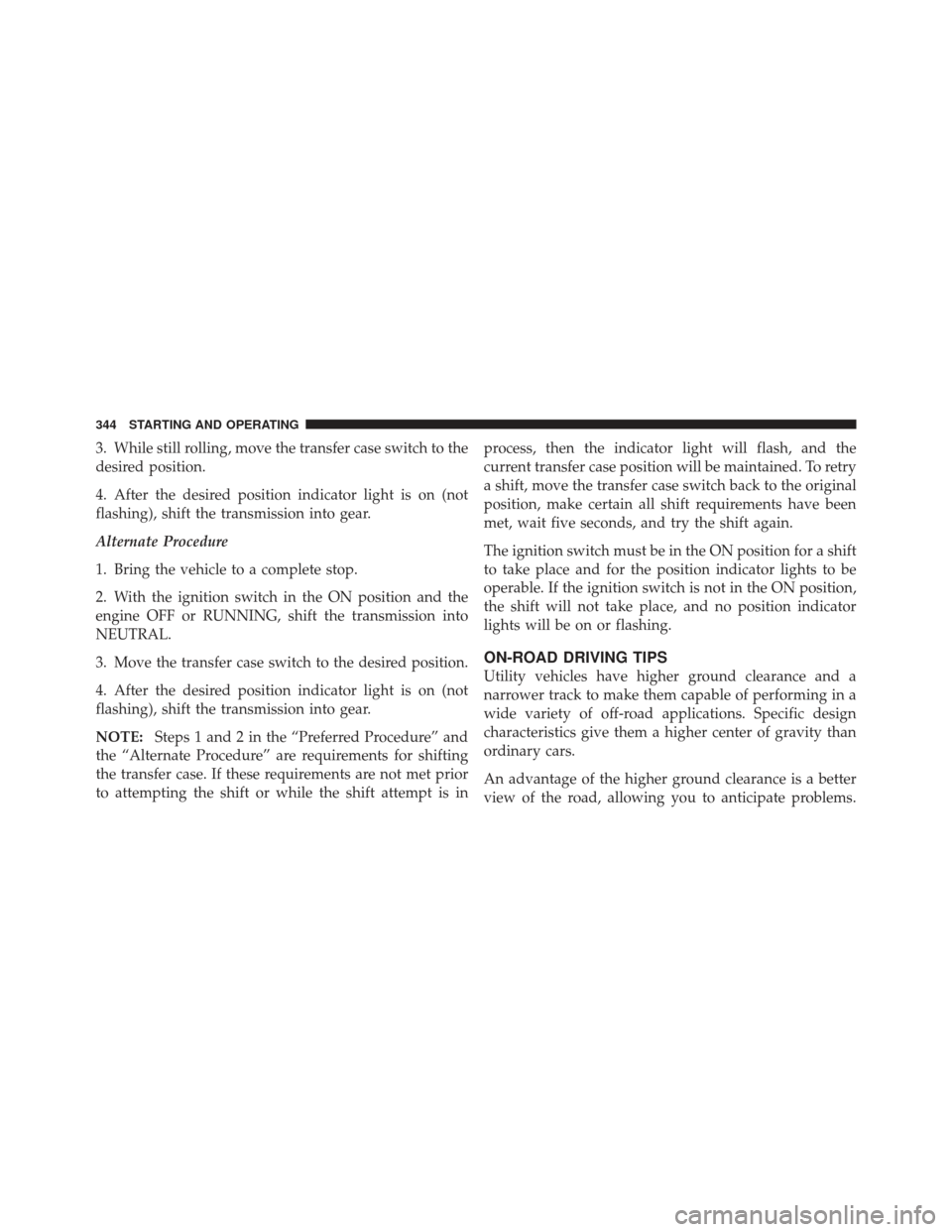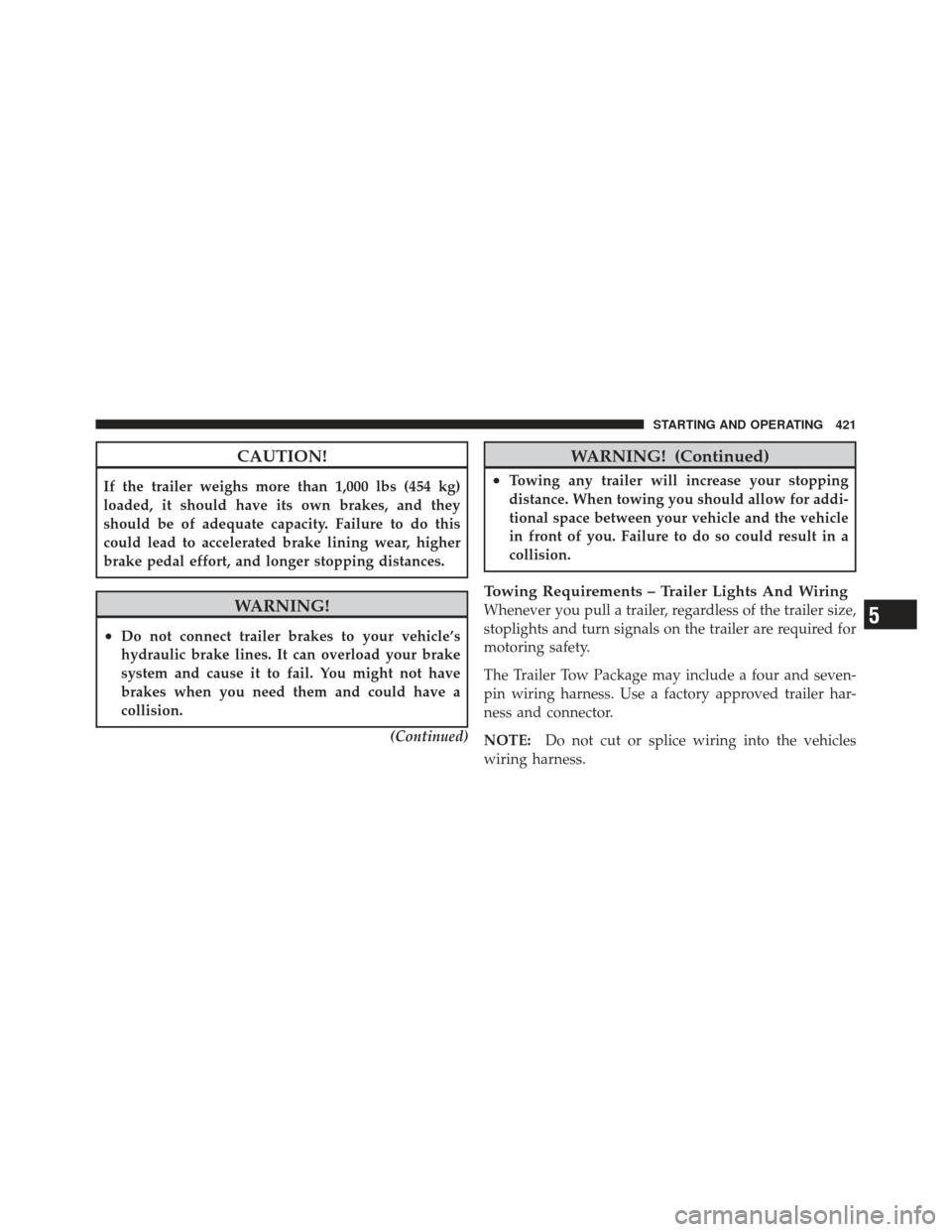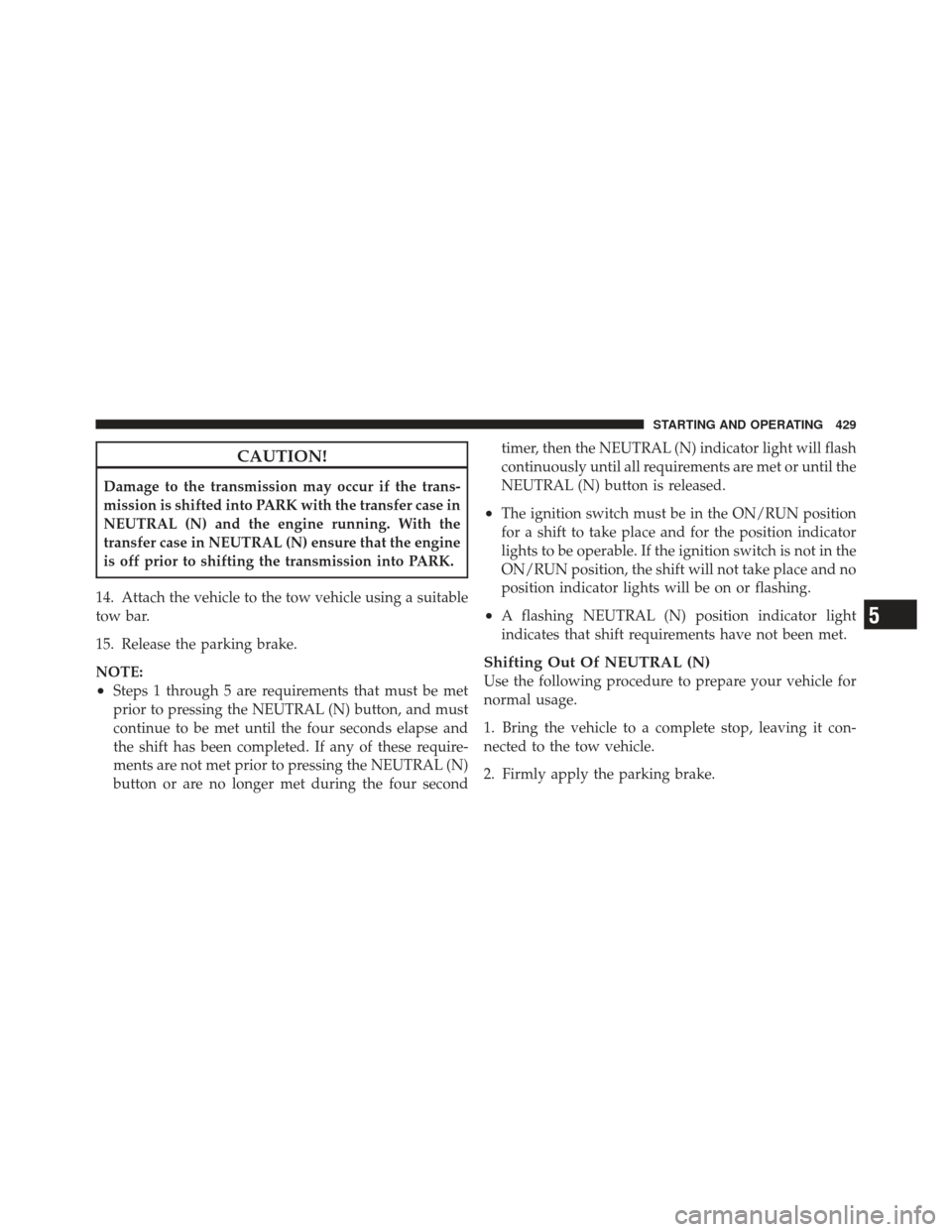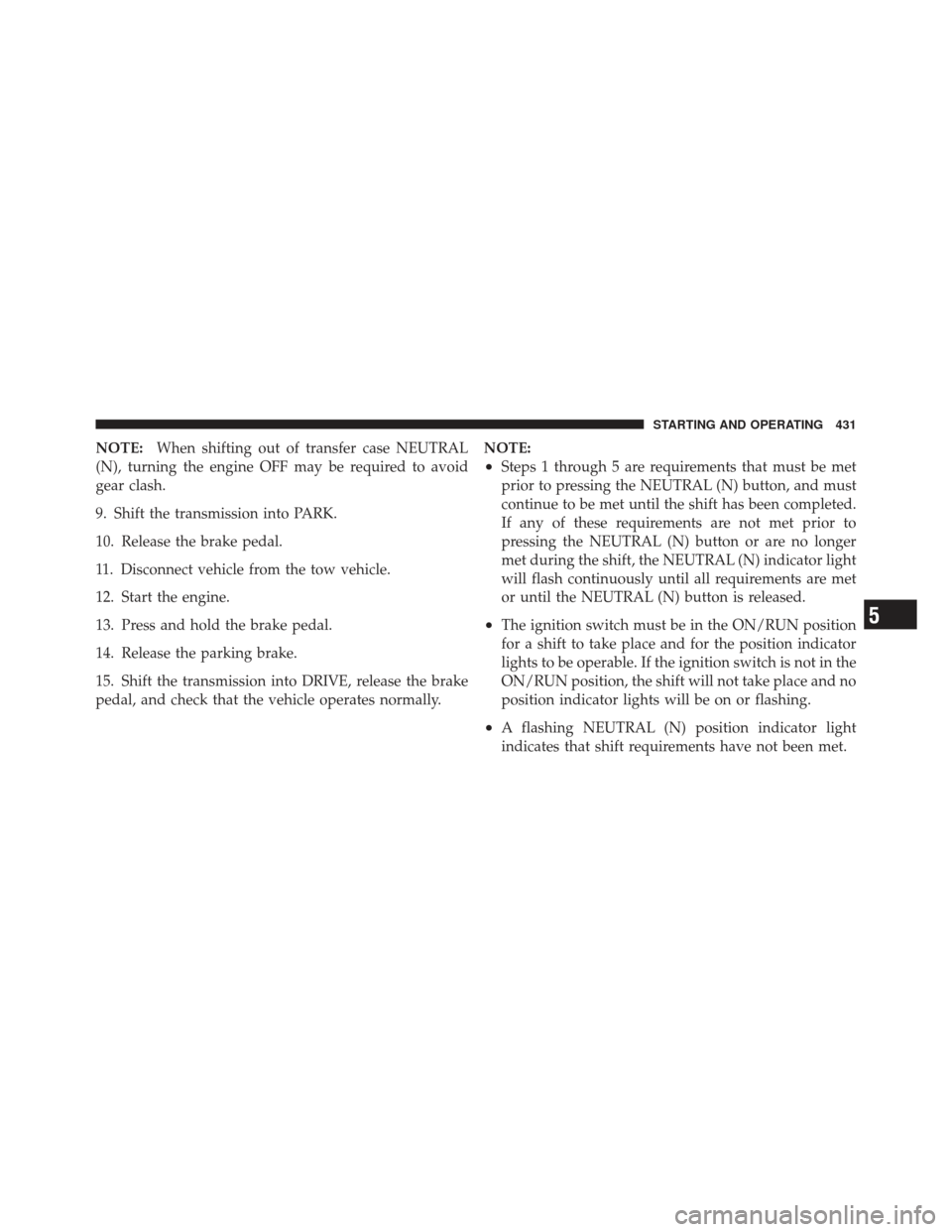Page 346 of 558

3. While still rolling, move the transfer case switch to the
desired position.
4. After the desired position indicator light is on (not
flashing), shift the transmission into gear.
Alternate Procedure
1. Bring the vehicle to a complete stop.
2. With the ignition switch in the ON position and the
engine OFF or RUNNING, shift the transmission into
NEUTRAL.
3. Move the transfer case switch to the desired position.
4. After the desired position indicator light is on (not
flashing), shift the transmission into gear.
NOTE:Steps 1 and 2 in the “Preferred Procedure” and
the “Alternate Procedure” are requirements for shifting
the transfer case. If these requirements are not met prior
to attempting the shift or while the shift attempt is in process, then the indicator light will flash, and the
current transfer case position will be maintained. To retry
a shift, move the transfer case switch back to the original
position, make certain all shift requirements have been
met, wait five seconds, and try the shift again.
The ignition switch must be in the ON position for a shift
to take place and for the position indicator lights to be
operable. If the ignition switch is not in the ON position,
the shift will not take place, and no position indicator
lights will be on or flashing.
ON-ROAD DRIVING TIPS
Utility vehicles have higher ground clearance and a
narrower track to make them capable of performing in a
wide variety of off-road applications. Specific design
characteristics give them a higher center of gravity than
ordinary cars.
An advantage of the higher ground clearance is a better
view of the road, allowing you to anticipate problems.
344 STARTING AND OPERATING
Page 423 of 558

CAUTION!
If the trailer weighs more than 1,000 lbs (454 kg)
loaded, it should have its own brakes, and they
should be of adequate capacity. Failure to do this
could lead to accelerated brake lining wear, higher
brake pedal effort, and longer stopping distances.
WARNING!
•Do not connect trailer brakes to your vehicle’s
hydraulic brake lines. It can overload your brake
system and cause it to fail. You might not have
brakes when you need them and could have a
collision.(Continued)
WARNING! (Continued)
•Towing any trailer will increase your stopping
distance. When towing you should allow for addi-
tional space between your vehicle and the vehicle
in front of you. Failure to do so could result in a
collision.
Towing Requirements – Trailer Lights And Wiring
Whenever you pull a trailer, regardless of the trailer size,
stoplights and turn signals on the trailer are required for
motoring safety.
The Trailer Tow Package may include a four and seven-
pin wiring harness. Use a factory approved trailer har-
ness and connector.
NOTE:Do not cut or splice wiring into the vehicles
wiring harness.5
STARTING AND OPERATING 421
Page 431 of 558

CAUTION!
Damage to the transmission may occur if the trans-
mission is shifted into PARK with the transfer case in
NEUTRAL (N) and the engine running. With the
transfer case in NEUTRAL (N) ensure that the engine
is off prior to shifting the transmission into PARK.
14. Attach the vehicle to the tow vehicle using a suitable
tow bar.
15. Release the parking brake.
NOTE:
•Steps 1 through 5 are requirements that must be met
prior to pressing the NEUTRAL (N) button, and must
continue to be met until the four seconds elapse and
the shift has been completed. If any of these require-
ments are not met prior to pressing the NEUTRAL (N)
button or are no longer met during the four second timer, then the NEUTRAL (N) indicator light will flash
continuously until all requirements are met or until the
NEUTRAL (N) button is released.
•The ignition switch must be in the ON/RUN position
for a shift to take place and for the position indicator
lights to be operable. If the ignition switch is not in the
ON/RUN position, the shift will not take place and no
position indicator lights will be on or flashing.
•A flashing NEUTRAL (N) position indicator light
indicates that shift requirements have not been met.
Shifting Out Of NEUTRAL (N)
Use the following procedure to prepare your vehicle for
normal usage.
1. Bring the vehicle to a complete stop, leaving it con-
nected to the tow vehicle.
2. Firmly apply the parking brake.
5
STARTING AND OPERATING 429
Page 433 of 558

NOTE:When shifting out of transfer case NEUTRAL
(N), turning the engine OFF may be required to avoid
gear clash.
9. Shift the transmission into PARK.
10. Release the brake pedal.
11. Disconnect vehicle from the tow vehicle.
12. Start the engine.
13. Press and hold the brake pedal.
14. Release the parking brake.
15. Shift the transmission into DRIVE, release the brake
pedal, and check that the vehicle operates normally. NOTE:
•Steps 1 through 5 are requirements that must be met
prior to pressing the NEUTRAL (N) button, and must
continue to be met until the shift has been completed.
If any of these requirements are not met prior to
pressing the NEUTRAL (N) button or are no longer
met during the shift, the NEUTRAL (N) indicator light
will flash continuously until all requirements are met
or until the NEUTRAL (N) button is released.
•The ignition switch must be in the ON/RUN position
for a shift to take place and for the position indicator
lights to be operable. If the ignition switch is not in the
ON/RUN position, the shift will not take place and no
position indicator lights will be on or flashing.
•A flashing NEUTRAL (N) position indicator light
indicates that shift requirements have not been met.
5
STARTING AND OPERATING 431
Page 493 of 558

Cleaning Headlights
Your vehicle has plastic headlights that are lighter and
less susceptible to stone breakage than glass headlights.
Plastic is not as scratch resistant as glass and therefore
different lens cleaning procedures must be followed.
To minimize the possibility of scratching the lenses and
reducing light output, avoid wiping with a dry cloth. To
remove road dirt, wash with a mild soap solution fol-
lowed by rinsing.
Do not use abrasive cleaning components, solvents, steel
wool or other aggressive material to clean the lenses.
Glass Surfaces
All glass surfaces should be cleaned on a regular basis
with MOPAR�Glass Cleaner or any commercial
household-type glass cleaner. Never use an abrasive type
cleaner. Use caution when cleaning the inside rear win-
dow equipped with electric defrosters or the right rear quarter window equipped with the radio antenna. Do
not use scrapers or other sharp instruments, which may
scratch the elements.
When cleaning the rear view mirror, spray cleaner on the
towel or rag that you are using. Do not spray cleaner
directly on the mirror.
Cleaning Plastic Instrument Cluster Lenses
The lenses in front of the instruments in this vehicle are
molded in clear plastic. When cleaning the lenses, care
must be taken to avoid scratching the plastic.
1. Clean with a wet soft rag. A mild soap solution may be
used, but do not use high alcohol content or abrasive
cleaners. If soap is used, wipe clean with a clean damp
rag.
2. Dry with a soft cloth.
7
MAINTAINING YOUR VEHICLE 491
Page 497 of 558
Cavity CartridgeFuseMini-
Fuse Description
M11 — 10 Amp RedClimate Control Sys-
tem – If Equipped
M12 — 30 Amp GreenRadio/Amplifier – If
Equipped
M13 — 20 Amp YellowInstrument Cluster/
Wireless Control
Module/
Multifunction Control
Switch, Siren – If
Equipped
M14 — 20 Amp YellowTrailer Tow (Export
Only) – If EquippedCavity Cartridge
FuseMini-
Fuse Description
M15 — 20 Amp YellowInstrument Cluster/
Rear View Mirror/
Tire Pressure
Monitor/Transfer
Case Module – If
Equipped/Glow
Plugs – If Equipped
M16 — 10 Amp RedAirbag Module
M17 — 15 Amp BlueExterior Lighting –
Left Front Park and
Side Marker, Left Tail
and Running, License
Lights
7
MAINTAINING YOUR VEHICLE 495
Page 498 of 558
Cavity CartridgeFuseMini-
Fuse Description
M18 — 15 Amp BlueExterior Lighting –
Right Front Park and
Side Marker, Right
Tail and Running
Lights
M19 — 25 Amp NaturalAutomatic Shutdown
#1 and #2
M20 — 15 Amp BlueInterior Lighting/
Steering Wheel
Switches – If
Equipped/Switch
Bank/Steering Col-
umn Module – If
Equipped
M21 — 20 Amp YellowAutomatic Shutdown
#3Cavity Cartridge
FuseMini-
Fuse Description
M22 — 10 Amp RedRight Horn (Hi/Low)
M23 — 10 Amp RedLeft Horn (Hi/Low)
M24 — 25 Amp NaturalRear Wiper – If
Equipped
M25 — 20 Amp YellowFuel Pump, Diesel
Lift Pump – If
Equipped
M26 — 10 Amp RedPower Mirror Switch/
Driver Window
Switch
M27 — 10 Amp RedIgnition Switch/
Wireless Control
Module/Steering Col-
umn Lock – If
Equipped
496 MAINTAINING YOUR VEHICLE
Page 499 of 558
Cavity CartridgeFuseMini-
Fuse Description
M28 — 10 Amp RedPowertrain Control
Module
M29 — 10 Amp RedOccupant Classifica-
tion Module
M30 — 15 Amp BlueRear Wiper Module –
If Equipped/Power
Folding Mirror – If
Equipped/Diagnostic
Link
M31 — 20 Amp YellowBack-Up Lights
M32 — 10 Amp RedAirbag Module
M33 — 10 Amp RedPowertrain Control
ModuleCavity Cartridge
FuseMini-
Fuse Description
M34 — 10 Amp RedPark Assist Module –
If Equipped/Climate
Control System Mod-
ule – If Equipped/
Compass Module – If
Equipped/Cabin
Heater – If
Equipped/Diesel Rad
Fan – If Equipped
M35 — 15 Amp BlueHeated Mirrors – If
Equipped
M36 — — —
7
MAINTAINING YOUR VEHICLE 497